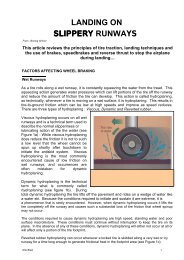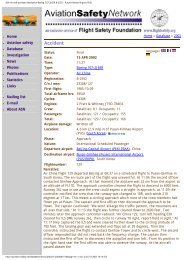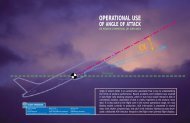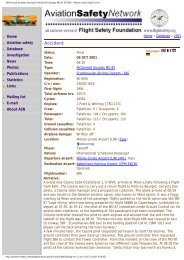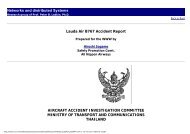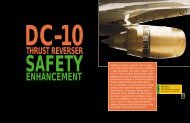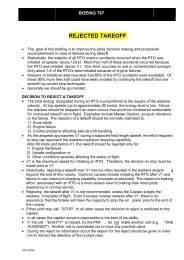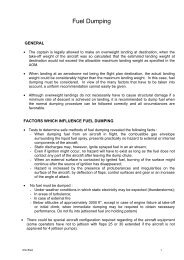Boeing 737-236 series 1, G-BGJL: Main document - Leonardo
Boeing 737-236 series 1, G-BGJL: Main document - Leonardo
Boeing 737-236 series 1, G-BGJL: Main document - Leonardo
You also want an ePaper? Increase the reach of your titles
YUMPU automatically turns print PDFs into web optimized ePapers that Google loves.
The upper skin on the left wing was torn upwards, the correspondingsections of lower skin were<br />
severely bulged downwards and theribs inside the tank were buckled. All of the damage to the<br />
leftwing structure, with the exception of the broken access panel,was consistent with a rapid overpressure<br />
of the tank cavity resultingfrom the ignition of fuel vapour within the tank.<br />
The rest of the airframe was free of mechanical damage, but hadsuffered extensive fire damage.<br />
1.12.1.4 Airframe fire damage - general<br />
The aircraft was extensively damaged by fire. Most of the lightalloy components in the aft region<br />
of the left engine nacellewere melted or burnt away. The left wing lower aft surfaces, largesections<br />
of the trailing edge flaps inboard of the engine andthe lower surfaces of the flaps outboard of the<br />
engine were melted,and the remaining regions of the left inner wing and the mainlanding gear bay<br />
were superficially fire-damaged. The lower skinof the left tailplane was burnt through over a region<br />
extendingapproximately 1 metre inboard from the tip.<br />
The rear fuselage was extensively burnt between the wing trailingedge and the rear doors; a large<br />
part of the left fuselage sidebetween frames 787 and 887 (approximately seat rows 17 to 21)was<br />
completely burnt away.(Appendix 8 Fig a) The wholeof the fuselage aft of the rear cargo door and<br />
the tail sectionhad collapsed onto the ground.<br />
Most of the passenger cabin ceiling and crown skins were burntaway (Appendix 8 Figs a-b) and all<br />
of the overhead luggagebins were destroyed. The support beams which carried the cabinfloor above<br />
the rear cargo hold were burnt away in the centralaisle area and on the right side of the cabin (in the<br />
areas immediatelyforward of, and aft of, the rear cargo door), allowing most ofthe cabin floor<br />
above the hold to collapse down onto the baggage.Most of the cabin interior fittings and seats in<br />
this sectionof the cabin were destroyed completely or were very extensivelydamaged. The interior<br />
fittings in the centre and forward sectionsof the cabin were generally less severely affected by the<br />
fire.However, there was considerable local variability, particularlyin the severity of seat damage.<br />
Notably, seats 8C and 9C (leftaisle seats just forward of the overwing exits) were<br />
completelydestroyed, whereas the adjoining seats were relatively intact.(Appendix 8 Fig c)<br />
1.12.2 Subsequent detailed examination<br />
1.12.2.1 Engines<br />
Following removal of the left engine it was transported to anoverhaul shop where it was stripped to<br />
its basic components. Thisshowed that, apart from damage to the combustion section it appearedto<br />
be generally in good condition, although it was noted thatsome turbine blade rubbing had occurred,<br />
apparently due to enginecase distortion after the CCOC rupture.<br />
All components of the combustion section of the engine were subjectedto detailed examination<br />
both at the manufacturer's premises andthe Royal Aircraft Establishment, Farnborough under AAIB<br />
supervision.In addition to a bench test in the overhaul shop, the FCU wasdespatched back to its<br />
manufacturer for testing.<br />
Only the dome portion of combustor can No 9 was subjected to detailedfractography, because the<br />
degree of burning and material losson the aft portion of the can precluded examination of the<br />
3rd/4thliner joint area. In the following description, positions of thecan fracture surface are by<br />
reference to 'clock' positions, viewedfrom the front with 12 o'clock being the mounting lug.<br />
From 10 o'clock to 2 o'clock, the fracture surface had sufferedconsiderable rubbing and, in the<br />
vicinity of the cross-over tubes,severe burning prevented identification of the nature of the



